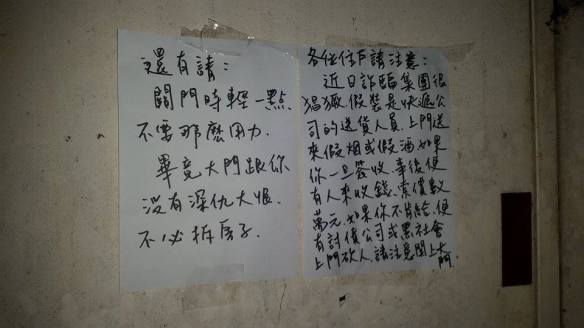It’s now well-documented how voracious my neighbours are in their appetite for note-writing, but they’ve outdone themselves once again with this in-depth study on the consequences of not closing the door and the art of door-closing itself:

Residents beware,
Recently con artists have been running rampant. They pretend to be express delivery men and come to your door with fake cigarettes and fake alcohol. As soon as you sign in receipt for the goods, later [sic.] people will come to collect money, asking for several tens of thousand of NT. If you don’t agree to give it to them, debt collectors or the mafia will come to your door and stick an axe in your face. Please be sure to close the door.
Don’t worry, this literary masterpiece is not complete yet, the author, having exhausted their veiled threats of mafia men and axe-chucking debt collectors, is fetching a new page to instruct us mere mortals on the true art of door closing:
Also,
Please close the door more lightly. Don’t do it so forcefully. Given that you don’t have anything against the door personally, you don’t need to bring the entire building down.
What I don’t understand is why would having the door closed fend off these roving hordes of axe-wielding con-artist delivery men. In case you are wondering… I do close the door, and try to close it lightly (even though it’s a natural slammer). I wonder when the English version will come out.
Is your building being peppered with notes? Have you been attacked by axe-wielding con-men and lived to tell the tale? Comment below or contact me!





